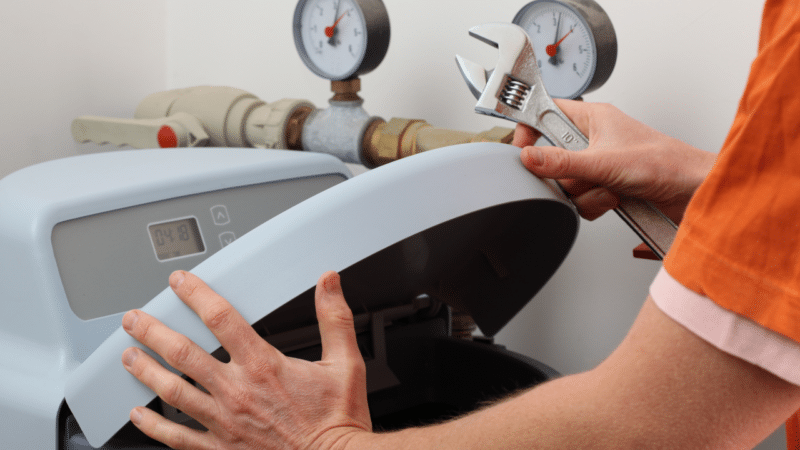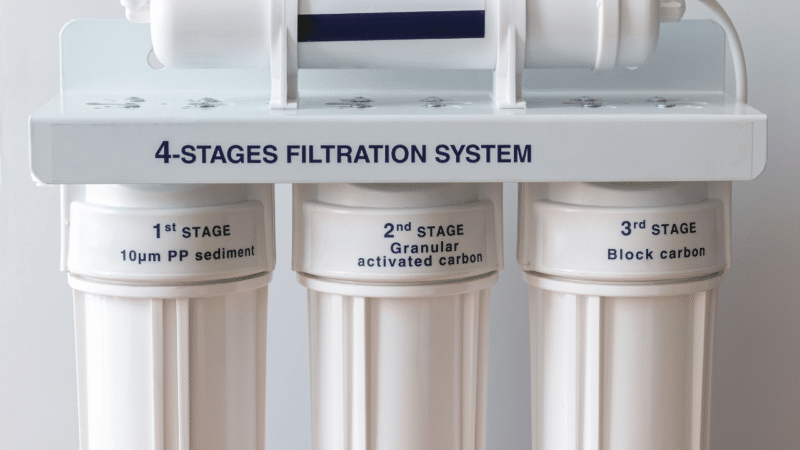In this article…
- What is a Slab Leak?
- What Causes a Slab Leak? 7 Common Factors
- How is a Slab Leak Detected?
- How Are Slab Leaks Repaired?
- 6 Risks of Leaving a Slab Leak Unrepaired
- Repairing A Slab Leak With The Right Plumbing Company
Have you noticed a random warm spot on your floor? Have new cracks suddenly appeared on your walls or concrete flooring?
These symptoms that are easy to ignore are common signs you may have a slab leak in your home’s plumbing under the foundation.
A slab leak can occur from the old age of your plumbing, corrosion of the piping, or damage to your plumbing after recent foundation work.
If left untreated, a slab leak can cause detrimental damage not only to your home’s plumbing but to its foundation as well. This is why understanding what signs indicate a slab leak may be present and why they occur is crucial to protecting your home and its longevity.
Jim’s Plumbing Now is the expert plumbing company in the Dallas/Fort Worth areas, specializing in simple plumbing services as well as full home repiping.
We work with dozens of local foundation companies to test and repair your plumbing after foundation work has occurred to avoid a future slab leak and maintain the integrity of your foundation.
While our team is composed of licensed, professional plumbers with decades of experience, we want you to know all about slab leaks so you can identify when you might have one and what to do next.
This article will define what a slab leak is, what causes a slab leak, how to repair a slab leak, and risks to be aware of if you leave a slab leak unrepaired.
After reading, you’ll have a full understanding of slab leaks and will know what to do in case you suspect a slab leak has occurred.
What is a Slab Leak?
A slab leak occurs when a water pipe underneath your home’s concrete foundation has a leak. These pipes can be part of your home’s plumbing system, carrying water to and from various fixtures.
Since the leak is beneath the foundation, it’s not always immediately obvious, but the signs can include:
- Sudden higher water bills
- Warm spots on your floors
- The sound of running water when no faucets or taps are on
- Visible cracks in walls or flooring
Addressing a potential slab leak at the first sign of one is important to avoid further damage to the rest of your home’s plumbing and your home’s foundation.
What Causes a Slab Leak? 7 Common Factors
Slab leaks can occur for several reasons, like environmental factors, deterioration and wear and tear, or issues during construction.
Knowing what potentially causes slab leaks helps you to understand how and why this occurred and will help you make the best-educated decision when looking at repair options.
Here are the most common causes of a slab leak.
1. Deterioration Due to Plumbing Age
Over time, all plumbing systems degrade, like any other appliance or product in our homes. Older homes, especially those built before the 1980s, are more prone to slab leaks due to old plumbing.
Pipes made from materials like galvanized steel or copper are susceptible to corrosion, especially when exposed to certain soil conditions or water with a high mineral content. Corrosion will create separation and holes in the piping, allowing a slab leak to occur.
Plumbing can also weaken after decades of use, increasing the likelihood of a leak.
2. Soil Shifting and Expansion
In areas like Texas with clay-rich and soft, loamy soil, it’s common for the ground beneath a home’s foundation can expand and contract due to changes in moisture levels.
During dry spells and drought, the soil contracts, leaving gaps that can strain or displace pipes. Periods of heavy rainfall will also cause the soil to expand, putting additional pressure on the foundation and the plumbing system beneath it.
When the soil continuously expands and contracts, it puts strain on your home’s foundation, potentially causing separation of the foundation and your plumbing.
3. Improper Installation
Proper installation is one of the most important factors when it comes to reinstalling new plumbing. If the plumbing under your home is not installed correctly, it could create future slab leaks.
Things like improperly fitted connections, the use of low-quality materials, and improper backfilling can cause your plumbing to fail and create a slab leak.
4. Water Chemistry and Pressure
The composition of your water plays a significant role in the longevity of your plumbing system.
Hard water with high mineral content can cause scaling inside pipes, leading to blockages and pressure buildup. If your water has low pH levels or is acidic, this can corrode metal pipes, weakening them from the inside out.
Excessively high water pressure puts additional stress on your plumbing system, particularly at joints and bends in the pipes. Both short-term high-pressure surges and ongoing pressure in your plumbing could cause pressure cracks and slab leaks to occur.
5. Tree Root Intrusion
In some cases, tree roots can grow toward the moisture of underground pipes and intrude on them, causing them to crack or break.
Roots naturally seek out water sources, and plumbing systems under slabs are prime targets. Once roots infiltrate the pipe, they can cause blockages, leaks, or even significant pipe damage.
6. Temperature Changes
Similar to how soil expands and contracts with the weather, your plumbing undergoes a similar process when temperatures change from hot to cold.
During unexpected freezes, water inside pipes can expand, causing them to crack or burst if not prepared for the weather.
This is why taking the right precautionary measures to protect your plumbing before winter is essential to avoid a potential pipe burst and slab leak.
7. Recent Foundation Repair
If you recently had foundation work on your home and had to raise your home on pillars, your plumbing may have been affected.
When your home is lifted, it puts strain on the plumbing and drain systems below the home. This can cause cracking or separation in the plumbing.
This is why hydrostatic and camera pinpoint testing is necessary after foundation repair to determine whether leaks are present, which can compromise your home if left unaddressed.
Read more about how foundation repair affects your home’s plumbing!
How is a Slab Leak Detected?
If you suspect there may be a slab leak below your home’s foundation, you want to understand how they are found and the next steps for repair.
The more educated you are about how to properly detect and repair a slab leak, the easier it will be to find a trustworthy plumbing company that can get the job done right.
There are several ways a professional plumber can detect and pinpoint a potential slab leak, from a simple visual inspection to a professional hydrostatic test, which we’ll explore here.
1. Visual Inspection
The first step in detecting a slab leak is a thorough visual inspection.
Common visual signs that may indicate a slab leak include water pooling around the foundation, cracks in walls, floors, or ceilings, areas of the floor that are unusually warm or damp, or sudden microbial growth around the home.
While these signs can indicate a potential slab leak, advanced detection methods are necessary to confirm the exact location and severity of the problem.
2. Electronic Listening Devices
Specialized listening equipment is used to detect the sound of water escaping from pipes. These devices are highly sensitive and can pick up the subtle noises caused by leaking water, even when the leak is deep beneath the foundation.
The device amplifies the sound of water movement, allowing the plumber to pinpoint the exact location of the leak without unnecessary digging or damage.
3. Thermal Imaging Cameras
Thermal imaging cameras are used to detect temperature changes caused by leaking hot water.
The plumber will scan the floor with a thermal camera to identify warm spots, which may indicate a hot water line leak.
This method is particularly effective for locating leaks in hot water pipes and is completely non-invasive.
4. Hydrostatic Pressure Testing
If you recently had foundation work completed on your home, a hydrostatic test is necessary to test the plumbing under your home for a slab leak.
First, a test ball is used to plug the drain system and create a pressurized environment. Then, the system is filled with water to the slab level. The water level is then monitored for at least 15 minutes by the plumber.
If the water level holds, there is no leak present. If the water level drops, it indicates a leak, and a camera pinpoint test is required.
5. Moisture Detection Tools
Moisture meters are another tool for slab leak detection. These devices measure the level of moisture in the concrete and other materials, allowing the plumber to identify areas affected by water leaks.
Moisture detection is particularly helpful for testing if you suspect there may be a slab leak but certain damages aren’t visible yet.
How Are Slab Leaks Repaired?
Once a slab leak has been properly detected, your plumber will provide a repair plan depending on the location of the leak source.
Repairing drain systems beneath a home’s foundation is typically done in three primary ways:
- Tunneling from the Exterior: This method involves digging tunnels from outside the home to access the damaged pipes beneath the foundation. It’s less invasive to the interior living space but can be more expensive and time-consuming, especially if the leak is not near the perimeter.
- Interior Breakout for Repair: In this approach, professionals break through the interior floors to reach the leak. While it provides direct access to the damaged area, it can disrupt daily activities and may require repairing flooring afterward.
- Rerouting the Plumbing System: This strategy involves abandoning the damaged pipes and installing new ones through a different path, often above the foundation. It’s beneficial when multiple leaks are present or pipes are extensively damaged, but it may involve modifications to walls or ceilings.
Each method is chosen based on factors like the leak’s location, the extent of damage, and cost considerations, and a professional plumber will help determine which repair plan is right for you.
6 Risks of Leaving a Slab Leak Unrepaired
If you suspect you may have a slab leak under your home, it’s important to have them addressed as soon as possible for proper testing and repair to avoid further damage to your home.
Slab leaks might start as small, hidden problems, but the consequences of ignoring them can be severe. To better understand the severity of a slab leak, let’s look at what risks to be aware of if a slab leak goes unrepaired.
1. Foundation Damage
One of the most significant risks is damage to your home’s foundation. Water leaking under the slab can erode the soil that supports the concrete, leading to:
- Soil Shifting: Uneven settling of the foundation, which can cause cracks in walls, ceilings, and floors.
- Structural Instability: If the foundation is compromised, it can result in costly repairs or even render your home unsafe.
2. Organic Microbial Growth
Water that seeps into your home’s foundation can create the perfect breeding ground for organic and microbial growth. This growth can spread to other areas of your home, causing:
- Health Hazards: Microbial growth can trigger allergies, asthma, and other respiratory issues, especially for children and those with weakened immune systems.
- Damage to Interiors: Mold can ruin carpets, drywall, and insulation, leading to extensive remediation costs.
3. Higher Water Bills
Even a small, undetected leak can waste hundreds (or even thousands) of gallons of water over time. This results in:
- Unexpected Expenses: A significant increase in your water bills without any noticeable change in your water usage habits.
- Wasted Water: Beyond the financial cost, slab leaks also waste water, which can be detrimental in drought-prone areas like Texas.
4. Flooding and Water Damage
If left unaddressed, a slab leak can eventually cause water to pool under or around your home. This can result in:
- Flooring Damage: Hardwood floors, carpets, and tiles can warp, crack, or become waterlogged.
- Basement Flooding: In homes with basements, water can seep in, causing additional structural and property damage.
5. Pest Infestations
Moisture attracts pests like termites, ants, and rodents. A slab leak can create a moist environment that encourages these unwelcome guests to move in. This can lead to:
- Damage to Wooden Structures: Termites thrive in damp environments, and they can quickly damage wooden supports.
- Health Risks: Pests can carry diseases and contaminate food and surfaces in your home.
6. Compromised Structural Integrity
Over time, water from a slab leak can weaken the materials used in your home’s construction, including wood, concrete, and metal. This can lead to:
- Buckling or Sagging Floors: The flooring above the leak may become uneven or warped.
- Cracked Walls and Ceilings: Prolonged exposure to moisture can cause structural materials to shift, leading to unsightly and costly cracks.
Overall, leaving a slab leak unrepaired is a damaging and costly risk. A slab leak will continue to weaken the integrity of your plumbing and the foundational slab of your home, causing irreversible damage that requires extensive repair.
Repairing A Slab Leak With The Right Plumbing Company
Now you have a robust understanding of all things regarding slab leaks, including what a slab leak is, what causes a slab leak, how they are detected and repaired, and what you risk if slab leaks are left untreated.
A slab leak can occur from many different factors, including foundation shifting or foundation repair, deterioration of your plumbing due to old age or hard water, or improper installation.
Knowing how to identify when you may have a slab leak is crucial to addressing the problem as quickly as possible. If you notice…
- Warm spots on your floors
- Unexpectedly higher water bills
- The sound of running water when no taps are on
- Or more cracking in your walls, floors, and ceilings
Contact a professional plumbing company to have them assess and diagnose the source of these issues which could be a slab leak.
Once the plumber has properly tested your plumbing system and found the source of the leak, they will provide the proper repair plan to fix your plumbing as quickly and efficiently as possible.
At Jim’s Plumbing Now, we perform dozens of hydrostatic tests each week and work closely with local foundation companies to test and repair plumbing under your home’s slab.
Along with our expert repairs, we’re here to educate you on everything you need to know about your home’s plumbing, from correctly identifying the problem to what repair plan is best for you.
If you suspect there is a slab leak or have noticed other plumbing issues around your home, finding a trustworthy, licensed plumbing company is the first step. However, we understand how tempting it can be to just hire a handyman plumber to save time and money on your project.
To help you find the best plumber for you, check out this article that outlines why you should hire a licensed plumber for your project and the risks of working with an unlicensed plumber.

Looking for a trustworthy, expert DFW plumber? Schedule your appointment with Jim’s Plumbing Now today!



